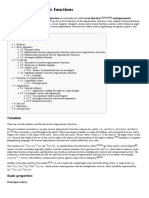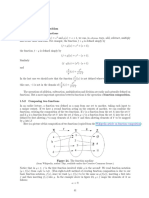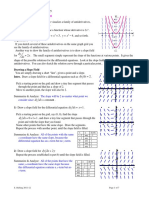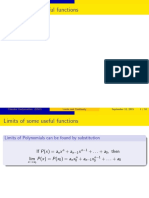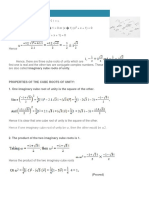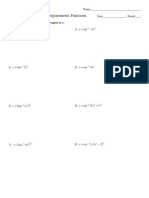19inverse Trig Functions
Uploaded by
vivek9519inverse Trig Functions
Uploaded by
vivek95www.rit.
edu/asc Page 1 of 7
I. Four Facts About Functions and Their Inverse Functions:
1. A function must be one-to-one (any horizontal line intersects it at
most once) in order to have an inverse function.
2. The graph of an inverse function is the reflection of the original
function about the line x y = .
3. If ) , ( y x is a point on the graph of the original function, then ) , ( x y is
a point on the graph of the inverse function.
4. The domain and range of a function and its inverse are
interchanged.
II. Illustration of the Four Facts for the Cosine Function:
Background: The regular cosine function for < < x , is not one-to-
one since some horizontal lines intersect the graph many times. (See
how the horizontal line 1 = y intersects the portion of the cosine function
graphed below in 3 places.) Therefore more than one x value is
associated with a single value. The inverse relationship would not be a
function as it would not pass the vertical line test.
Inverse Trig
Functions
x y =
y
x
1 = y
x y cos =
2 2
x y
1
cos
=
www.rit.edu/asc Page 2 of 7
FACT #1: A function must be one-to-one (any horizontal line intersects it at
most once) in order to have an inverse function.
The restricted cosine function, x y cos = on the interval x 0 is one-to-
one and does have an inverse function called x arccos or x
1
cos
. See the
graphs of the restricted cosine function and its inverse function below:
FACT #2: The graph of an inverse function is the reflection of the original
function about the line x y = .
Note the symmetry of graphs of x cos and x arccos about the line x y = .
FACT #3: If ) , ( y x is a point on the graph of the original function, then ) , ( x y
is a point on the graph of the inverse function.
2
1
,
3
is a point on the graph of x y cos =
2
1
3
cos =
3
,
2
1
is a point on the graph of x y arccos =
3 2
1
arccos
=
In general, if y x = arccos , then y x cos = . ( y x =
1
cos implies x y = cos )
x y =
1
2
x y cos =
x y
1
cos
=
y
x
www.rit.edu/asc Page 3 of 7
FACT #4: The domain and range of a function and its inverse are
interchanged.
x cos x arccos
Domain
x 0
(restricted domain)
1 1 x
Range
1 1 y
y 0
(restricted range)
Example: Evaluate
2
3
arccos .
Solution: The question being asked is What angle has a cosine value of
2
3
?
Usually there are an infinite number of solutions because cosine is
periodic and equals this value twice each and every period. However,
for the x arccos function we are looking for the answer in the
restricted range. From the above work, we know the range of
x arccos is y 0 . So the question being asked is more precisely,
What angle between 0 and has a cosine value of
2
3
?
Since cosine is negative for angles in the 2
nd
quadrant and the
reference angle is
6
, the final answer is
6
5
.
6
5
y
x
www.rit.edu/asc Page 4 of 7
III. Other Inverse Trigonometric Functions:
Each trigonometric function has a restricted domain for which an
inverse function is defined. The restricted domains are determined so
the trig functions are one-to-one.
Graphs:
x y sin = : x x y
1
sin arcsin
= = :
x y cos = : x x y
1
cos arccos
= = :
x y tan = : x x y
1
tan arctan
= = :
Trig
function
Restricted
domain
Inverse trig
function
Principle value
range
x y sin =
2 2
x x y arcsin =
2 2
y
x y cos =
x 0
x y arccos =
y 0
x y tan =
2 2
< < x
x y arctan =
2 2
< < y
1
2
1
2
1
1
2
1
1
1
y
y
y
y
y
y
x
x
x x
x x
www.rit.edu/asc Page 5 of 7
Example #1: Evaluate
=
2
1
arcsin y .
HINT: Find the angle whose sine value equals
2
1
. The answer must be in the
principle range of
2 2
y .
Answer:
6
Example #2: Evaluate )
2
1
arccos( = y .
HINT: Find the angle whose cosine value equals
2
1
. The answer must be in the
principle range of y 0 .
Answer:
3
2
Example #3: Evaluate ) 1 arctan( = y .
HINT: Find the angle whose tangent value equals 1 . The answer must be in the
principle range of
2 2
< < y .
Answer:
4
**Alternate notation for the above examples: Evaluate
2
1
sin
1
,
2
1
cos
1
,
) 1 ( tan
1
.
www.rit.edu/asc Page 6 of 7
Example #4:
Calculator Example
If the length of two legs of a right triangle are 7 and 10, find the measure of the
larger acute angle.
PROBLEMS:
1. Evaluate:
a) ) 0 arccos( b)
2
2
arccos c) ) 1 ( cos
1
d) ) 1 ( cos
1
e) ) 0 ( sin
1
f) )
2
3
arcsin( g) ) 3 arctan( h) ) 3 ( tan
1
2. Find the measure of the acute angles in a right triangle with a hypotenuse of
length 10 and a side of length 7.
10
7
A
B
Solution:
Acute angle B is larger than angle A since the
side opposite B (side 10 = b ) is larger than the
side opposite A (side 7 = a ).
7
10
tan = =
adj
opp
B
=
7
10
tan
7
10
arctan
1
B
= 55 B or
36
11
180
55
=
radians
www.rit.edu/asc Page 7 of 7
ANSWERS:
1. a)
2
b)
4
c) d) 0
e) 0 f)
3
g)
3
h)
3
2. =
4 . 44
10
7
arcsin
10
7
sin
1
. The other angle = 6 . 45 4 . 44 90 .
Alternate solution: =
6 . 45
10
7
arccos
10
7
cos
1
. The other angle
= 4 . 44 6 . 45 90 .
You might also like
- Inverse Trigonometric Functions (Trigonometry) Mathematics Question BankFrom EverandInverse Trigonometric Functions (Trigonometry) Mathematics Question BankNo ratings yet
- Application of Graphs and Trigonometric Ratios of Compound AnglesNo ratings yetApplication of Graphs and Trigonometric Ratios of Compound Angles13 pages
- 1.5 Function Composition: (From Wikipedia, Author Tlep, Available Under The Creative Commons License.)No ratings yet1.5 Function Composition: (From Wikipedia, Author Tlep, Available Under The Creative Commons License.)5 pages
- Solve System of Equations Using GraphingNo ratings yetSolve System of Equations Using Graphing42 pages
- D. Inverse Trigonometric Functions: One-To-One OntoNo ratings yetD. Inverse Trigonometric Functions: One-To-One Onto69 pages
- JEE+Crash+course+ +Phase+I+ +Sequence+and+Series+ +vmathNo ratings yetJEE+Crash+course+ +Phase+I+ +Sequence+and+Series+ +vmath121 pages
- Applications of First Order Differential EquationsNo ratings yetApplications of First Order Differential Equations57 pages
- Dy X DX y X y X y X y X C: AP Slope Fields WorksheetNo ratings yetDy X DX y X y X y X y X C: AP Slope Fields Worksheet7 pages
- 2020 JC 2 H2 Math Consolidation Test II (Solutions)No ratings yet2020 JC 2 H2 Math Consolidation Test II (Solutions)13 pages
- Limits and Continuity II Presentation SlidesNo ratings yetLimits and Continuity II Presentation Slides37 pages
- Function Operations and Composition of FunctionsNo ratings yetFunction Operations and Composition of Functions29 pages
- 6 2 Evaluating and Graphing Polynomial FunctionsNo ratings yet6 2 Evaluating and Graphing Polynomial Functions15 pages
- Functions of Complex Variable: Function, Domain and RangeNo ratings yetFunctions of Complex Variable: Function, Domain and Range9 pages
- V Best Chapter 1.1 Quadratics - ONLINE PDFNo ratings yetV Best Chapter 1.1 Quadratics - ONLINE PDF16 pages
- SAT II Math Level 2 Subject Test Notes: Trigonometric Functions100% (1)SAT II Math Level 2 Subject Test Notes: Trigonometric Functions4 pages
- Inverse Trigonometric Functions: Four Facts About Functions and Their Inverse FunctionsNo ratings yetInverse Trigonometric Functions: Four Facts About Functions and Their Inverse Functions7 pages
- D 1.1.1 (Matrix) A Rectangular Array of Numbers Is Called A MatrixNo ratings yetD 1.1.1 (Matrix) A Rectangular Array of Numbers Is Called A Matrix17 pages
- Excerpts From Sanjay Baru's Book 'The Accidental Prime Minister - The Making and Unmaking of Manmohan Singh' - India Today100% (2)Excerpts From Sanjay Baru's Book 'The Accidental Prime Minister - The Making and Unmaking of Manmohan Singh' - India Today13 pages
- Instant download Single Variable Calculus 1st Edition Soo T. Tan pdf all chapterNo ratings yetInstant download Single Variable Calculus 1st Edition Soo T. Tan pdf all chapter51 pages
- 9.4 9.5 Trig Ratios: Find The Values of X, Y, and ZNo ratings yet9.4 9.5 Trig Ratios: Find The Values of X, Y, and Z3 pages
- Chapter 5: Trigonometry: 5.1 Introduction of Trigonometry FunctionNo ratings yetChapter 5: Trigonometry: 5.1 Introduction of Trigonometry Function21 pages
- Licence Category B1 and B2: MathematicsNo ratings yetLicence Category B1 and B2: Mathematics62 pages
- Keystone Algebra 1 Simplifying Exponential Expressions WS2No ratings yetKeystone Algebra 1 Simplifying Exponential Expressions WS24 pages
- All Trigonometric Identities and FormulasNo ratings yetAll Trigonometric Identities and Formulas5 pages
- Right Triangles and Trigonometry Practice TestNo ratings yetRight Triangles and Trigonometry Practice Test6 pages
- E-Book 'Pure Maths Part Four Trigonometry' From A-Level Maths Tutor100% (4)E-Book 'Pure Maths Part Four Trigonometry' From A-Level Maths Tutor29 pages
- Math Handbook Formulas Trigonometry by Earl Whitney100% (2)Math Handbook Formulas Trigonometry by Earl Whitney109 pages
- MTH 133. Plane Trigonometry-Syllabus MTH 133. Plane Trigonometry-SyllabusNo ratings yetMTH 133. Plane Trigonometry-Syllabus MTH 133. Plane Trigonometry-Syllabus6 pages
- R S Aggarwal Solution Class 11 Maths Chapter 28 DifferentiationNo ratings yetR S Aggarwal Solution Class 11 Maths Chapter 28 Differentiation27 pages
- Inverse Trigonometric Functions (Trigonometry) Mathematics Question BankFrom EverandInverse Trigonometric Functions (Trigonometry) Mathematics Question Bank
- Application of Graphs and Trigonometric Ratios of Compound AnglesApplication of Graphs and Trigonometric Ratios of Compound Angles
- 1.5 Function Composition: (From Wikipedia, Author Tlep, Available Under The Creative Commons License.)1.5 Function Composition: (From Wikipedia, Author Tlep, Available Under The Creative Commons License.)
- D. Inverse Trigonometric Functions: One-To-One OntoD. Inverse Trigonometric Functions: One-To-One Onto
- JEE+Crash+course+ +Phase+I+ +Sequence+and+Series+ +vmathJEE+Crash+course+ +Phase+I+ +Sequence+and+Series+ +vmath
- Applications of First Order Differential EquationsApplications of First Order Differential Equations
- Dy X DX y X y X y X y X C: AP Slope Fields WorksheetDy X DX y X y X y X y X C: AP Slope Fields Worksheet
- 2020 JC 2 H2 Math Consolidation Test II (Solutions)2020 JC 2 H2 Math Consolidation Test II (Solutions)
- Functions of Complex Variable: Function, Domain and RangeFunctions of Complex Variable: Function, Domain and Range
- SAT II Math Level 2 Subject Test Notes: Trigonometric FunctionsSAT II Math Level 2 Subject Test Notes: Trigonometric Functions
- Inverse Trigonometric Functions: Four Facts About Functions and Their Inverse FunctionsInverse Trigonometric Functions: Four Facts About Functions and Their Inverse Functions
- D 1.1.1 (Matrix) A Rectangular Array of Numbers Is Called A MatrixD 1.1.1 (Matrix) A Rectangular Array of Numbers Is Called A Matrix
- Excerpts From Sanjay Baru's Book 'The Accidental Prime Minister - The Making and Unmaking of Manmohan Singh' - India TodayExcerpts From Sanjay Baru's Book 'The Accidental Prime Minister - The Making and Unmaking of Manmohan Singh' - India Today
- Instant download Single Variable Calculus 1st Edition Soo T. Tan pdf all chapterInstant download Single Variable Calculus 1st Edition Soo T. Tan pdf all chapter
- 9.4 9.5 Trig Ratios: Find The Values of X, Y, and Z9.4 9.5 Trig Ratios: Find The Values of X, Y, and Z
- Chapter 5: Trigonometry: 5.1 Introduction of Trigonometry FunctionChapter 5: Trigonometry: 5.1 Introduction of Trigonometry Function
- Keystone Algebra 1 Simplifying Exponential Expressions WS2Keystone Algebra 1 Simplifying Exponential Expressions WS2
- E-Book 'Pure Maths Part Four Trigonometry' From A-Level Maths TutorE-Book 'Pure Maths Part Four Trigonometry' From A-Level Maths Tutor
- Math Handbook Formulas Trigonometry by Earl WhitneyMath Handbook Formulas Trigonometry by Earl Whitney
- MTH 133. Plane Trigonometry-Syllabus MTH 133. Plane Trigonometry-SyllabusMTH 133. Plane Trigonometry-Syllabus MTH 133. Plane Trigonometry-Syllabus
- R S Aggarwal Solution Class 11 Maths Chapter 28 DifferentiationR S Aggarwal Solution Class 11 Maths Chapter 28 Differentiation






